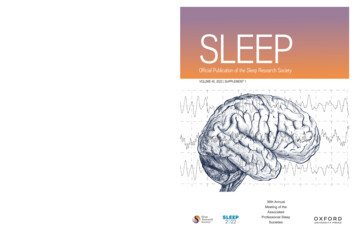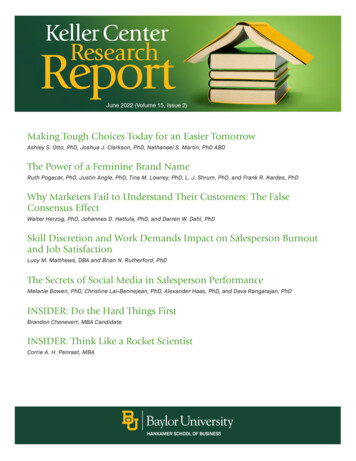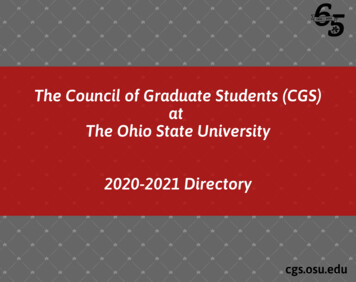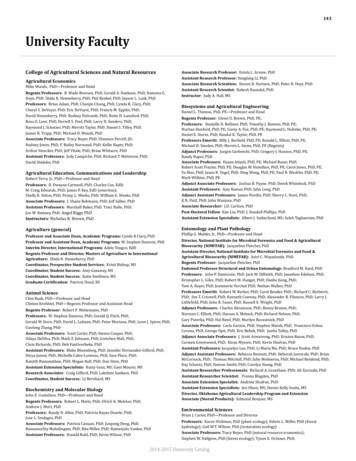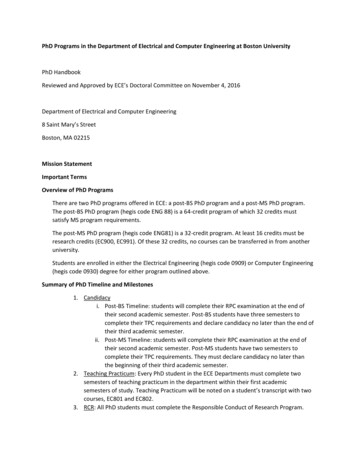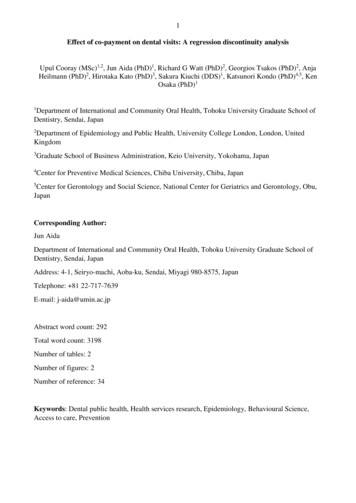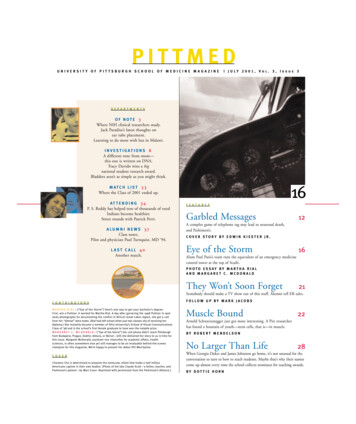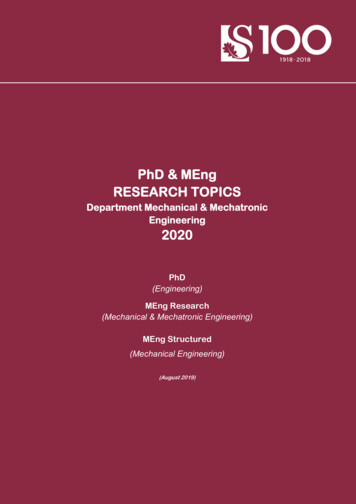
Transcription
DIPhD & MEngRESEARCH TOPICSDepartment Mechanical & MechatronicEngineering2020PhD(Engineering)MEng Research(Mechanical & Mechatronic Engineering)MEng Structured(Mechanical Engineering)(August 2019)
Table of ContentsDesign & Mechatronics DivisionProf AH Basson & Dr K KrugerProf C CoetzeeDr DNJ ElsProf PR FourieMrs LC GinsbergProf M NieuwoudtProf K SchreveDr WJ SmitProf D van den HeeverDr J van der MerweMechanics DivisionProf A BekkerProf TH BeckerProf DC BlaineProf AA GroenwoldProf G VenterDr MP VenterThermo Fluids DivisionDr JE HoffmannDr MTF OwenProf SJ van der SpuyProf TW von BackströmRenewable EnergyDr JE HoffmannProf C McGregorDr MTF OwenProf SJ van der SpuyProf TW von Backström
DIDesign & MechatronicsDivision
Lecturer:Prof Anton BassonDr Karel ac.za ;kkruger@sun.ac.za 27 21 808 4250/ 27 21 808 4258A214 /A605Department:Mechanical and Mechatronic EngineeringDivision:Design & Mechatronics / Mechanics / Thermo Fluids / Renewable EnergyResearch field:Industry 4.0 and Cyber-Physical SystemsGeneral description of research field:The fourth industrial revolution, or Industry 4.0, is the current trend of automation and data exchange inmanufacturing technologies, and there is a growing interest in many other domains as well. The Industry 4.0vision is reliant on certain enabling technologies, such as cyber-physical systems (CPSs), the Internet of Thingsand cloud computing. Our research focusses on the development of reality-reflecting architectures for the multidomain implementation of three levels of CPSs:(1) In the "Smart Connection Level", issues such as tether-free communication and sensor networks areconsidered.(2) The "Data-to-Information Conversion Level" considers issues such as smart analytics for componentmachine health and degradation and performance prediction.(3) The "Cyber Level" considers issues such as the twin model (or digital twin) for components and machines,machine time-variation identification and memory, and data clustering for data mining.We are also considering the role of humans, both as task executors and decision makers, within Industry 4.0environments. We are interested in the adaptation of control architectures and the use of technology (e.g.collaborative robots and wearable eye-tracking systems) to facilitate the integration of humans in CPSs.List of topics:1. Technologies for implementing a "digital twin" in aCPS, for both automated systems and humans. Thisincludes modelling techniques for the physicalsystem's behaviour in the digital world, methods andformats for information exchange between the digitaland physical systems, as well as between the digitaltwin and the cyber-space.2. The development of an Erlang-based framework tofacilitate implementation architectures for CPS.Erlang is a functional programming language thatoffers advantages in modularity, concurrency andfault tolerance – all of which are important in variouslevels of CPS XXXFundingAt least 1 x MEngor PhDSpecific requirements:Although preference is given to Mechanical and Mechatronic Engineering graduates, students from otherengineering backgrounds will also be considered.
Lecturer:Prof Corné Tel: 27 21 808 4239Office:M157Department:Mechanical and Mechatronic EngineeringDivision:Design & Mechatronics / Mechanics / Thermo Fluids / Renewable EnergyResearch field:The modelling of bulk materials handling in the mining and agricultural sectors.The improvement of fruit packaging in terms of cooling and structural strength.General description of research field:The Discrete Element Method (DEM) is a numerical method used to model granular materials and industrialprocesses. Mining applications include the calibration of material properties as well as the modelling of typicalmining processes such as the flow of ore on conveyor belts, transfer chutes and hoppers. The aim of such a studywould be to optimise the process in terms of mass flow rates while limiting wear and spillage. Agriculturalapplications include the modelling of post-harvest fruit handling to predict damage and bruising and soil-toolinteraction with the aim of improving the implements.Packaging (plastic bags, carton boxes, etc.) is used to protect fruit during handling and transportation. However,the fruit need to be kept cooled while mechanical damage should be minimised. Boxes that are structurallystrong will prevent any mechanical damage such as bruising but might prevent proper cooling of the fruit. On theother hand, a box which will allow the fruit to cool properly might not be able to prevent mechanical damage.The optimum design should be found.List of topics:1. The modelling of bulk granular materials using theDiscrete Element Method (DEM). This will includeexperimental work using our unique large scaleconveyor test facility, the calibration of materialproperties, and DEM modelling. The aim would be todevelop experimental and numerical methods forcalibrating the material properties of wet cohesive(sticky) materials. The methods should be validated bycomparing the predicted material flow rates, flowpatterns, build-up, etc. with measurements andobservations. Applications of these methods wouldbe in the mining and agricultural sectors.2. The modelling of fruit packaging using the FiniteElement Method (FEM). The properties of paperboardused to manufacture boxes should be measured andused in a FEM model to predict the structural strengthof the box under different loading and environmentalconditions such as changes in temperature, humidityand creep loading. This will include experimentallaboratory and field work as well as FEM modelling incollaboration with the department of horticulturalsciences at Stellenbosch University.Specific requirements:Finite Element Method where applicable.MEng(Structured)MEng(Research) PhD FundingPossibility offunding for:1 x PhD1 x MEng Possibility offunding for:1 x PhD1 x MEng
Lecturer:Dr Danie ElsFaculty:EngineeringEmail:dnjels@sun.ac.zaTel: 27 21 808 4248Office:M216Department:Mechanical and Mechatronic EngineeringDivision:Design & Mechatronics / Mechanics / Thermo Fluids / Renewable EnergyResearch field:a. Large Industrial Gearbox Performance and Analysisb. Agricultural EngineeringGeneral description of research field:a. Gearboxes: The main purpose of this research is the investigation of the effect of fan vibrations, startup loads and the gearbox-motor dynamic motion on the gearbox loads and gear and bearing fatiguelife.b. Agriculture: The optimal management of water resources in viticulture and agricultural in general is atopic of particular relevance in the Western Cape. The focus is on the detection of waters stress inplants. These project is a collaboration between the Departments of Mechanical and MechatronicEngineering and of Viticulture at Stellenbosch University.List of topics:1. Investigation of Air-Cooled Condenser undingX1 x MEng2. Develop a low-cost infrared system to detect waterstress in vineyards.X1 x MEng3. Develop an automated Leaf Stem Water PotentialMeasurement systemXSpecific requirements:
Lecturer:Prof Pieter el: 27 82 551 1845Office:LaunchlabDepartment:Mechanical and Mechatronic EngineeringDivision:Design & Mechatronics / Mechanics / Thermo Fluids / Renewable EnergyResearch field:Biomedical EngineeringGeneral description of research field:Research and Development of applications from the engineering field (specifically mechatronics) in the area ofmedicine and health related problems.List of topics:1. Neuro-feedback Applied to Improve ConcentrationUsing a Single Intra-Ear EEGMEng(Structured)MEng(Research)X2. Identifying the Impedance of the Epidural EpiduralSpace for Application in Epidural AnaesthesiaX3. Development of a Fundus Camera Applying a UniqueFocus MethodologyX4. Effect of Music on Speech Development in Childrenwith an Autistic Spectrum DisorderX5. Brain Cooling Applying an Acoustic Cooling TechniqueSpecific requirements:XPhDFunding
Lecturer:Mrs Liora aTel: 27 21 808 4084Office:S371Department:Mechanical and Mechatronic EngineeringDivision:Design & Mechatronics / Mechanics / Thermo Fluids / Renewable EnergyResearch field:Biomedical engineering - Microcirculation flow pattern in the lymphGeneral description of research field:The lymphatic system is an important biological system, with main functions of immunity and transportation ofexcess fluid from amongst the capillaries in the loose connective tissue into the vascular system. Much researchhas been conducted on the flow patterns of the circulatory system, into which the lymphatic system flows,however little has been attempted on the lymphatic system.Parametric studies and numerical modelling of the micro-circulation of specific regions of the lymphatic systemneed to be conducted. The project takes place in the context on on-going final year projects and a PhD study.List of topics:1. CFD studies of detail micro-circulation in a lymphaticsegment / duct2. Studies in micro flow of the lymphatic network systemSpecific DFunding
Lecturer:Prof Martin c.zaTel: 27 21 808 9040Office:M3032Department/s:Institute for Biomedical Engineering (IBE)Mechanical and Mechatronic EngineeringDivision:Design & Mechatronics / Mechanics / Thermo Fluids / Renewable EnergyIBEResearch field:Biomedical EngineeringGeneral description of research field:The following Research Topics are applications at the intersection of molecular biology, robotics, fluidics andmachine learning engineering.The applications all have predefined market needs, i.e. a client from Industry. Successful completion may leadto employment opportunities.List of topics:1. Development of a viral load pooling robotic esXYes, possibleXYes, possibleXYes, possible5. Development of an on-line chemical Reactor toproduce a hypochlorous free-radical solutionXYes6. Development of a safe, micro-sample extractor forthe Gene Expert platformX2. Development of a nucleic acid collecting electrode3. Development of a microfluidic lymphocyte isolationsystem4. Development of a bacterial isolation systemXYesXYesXXYes, possibleXXYes, possible7. Patient-specific 3D bioprinting of tissue engineeredhydrogels8. Machine Learning for Biomarker identification inDiabetes and other diseases9. Machine Learning for Medical Image AnalysisSpecific requirements:
Lecturer:Prof Kristiaan Tel: 27 21 808 4091Office:M2114Department:Mechanical and Mechatronic EngineeringDivision:Design & Mechatronics / Mechanics / Thermo Fluids / Renewable EnergyResearch field:Robot navigation & metrology.General description of research field:Motion analysis of athletes with stationary cameras such as the Vicon system does not allow tracking athletes inlarge scale outdoor environments. Understanding the complex motions involved in disciplines such as mountainbiking requires new technologies. With Dr’s Smit and Müller, we propose to develop a mobile system relying onUAV-borne camera tracking of a mountain biker on an actual track. This part of the project is about accuratelylocating the UAV (or robot) so that certain markers on the biker can be tracked at high precision. This project isin collaboration with Dr’s Smit and Müller who are respectively looking at the UAV control and body modelaspects.Micro-metrology and optical metrology are exciting new measurement techniques being used more and moreby industry. We are busy with various metrology projects, in close collaboration with industry partners. Opticalmetrology has wide application: manufacturing, quality control, robotics, navigation, medicine, etc. Our focus ison precision. Micro-metrology is an emerging field of high precision measurement with many exciting hightechnology applications.List of topics:MEng(Structured)MEng(Research)PhDFunding1. High precision dimensional metrologyXXApplythroughCSIR/DST before28 Sept.2. Constraining the SLAM feature tracking algorithmwith the body modelXXNRF funding3. Quantifying the impact of the sensor capabilities onthe UAV localisationXXNRF funding4. Finding an optimal sensor array to achieve therequired marker localisation accuracyXXNRF funding5. Optical metrologyXXApplythroughCSIR/DST before28 Sept.Specific requirements:
Lecturer:Dr Willie SmitFaculty:EngineeringEmail:wjsmit@sun.ac.zaTel: 27 21 808 4046Office:S371Department:Mechanical and Mechatronic EngineeringDivision:Design & Mechatronics / Mechanics / Thermo Fluids / Renewable EnergyResearch field:Robotics, Autonomous heliostat fields.General description of research field:The Solar Thermal Energy Research Group (STERG) is developing an autonomous heliostat field. Thisheliostat field will be used to provide process heat for applications like sinter plants and smelters. Wethink that drones and ground based robots will be able to service an autonomous heliostat field.List of topics:1. Design, build and test a quadcopter with a novelconfiguration for endurance flights.MEng(Structured)MEng(Research)X2. Develop a small, low-cost, high quality heliostatfacet.X3. Improve the state-estimation of a multirotor byusing sensor fusion.XSpecific requirements:PhDXFunding
Lecturer:Prof Dawie van den HeeverFaculty:EngineeringEmail:dawie@sun.ac.zaTel: 27 21 808 4856Office:M3033Department:Mechanical and Mechatronic EngineeringDivision:Design & Mechatronics / Mechanics / Thermo Fluids / Renewable EnergyResearch field:Biomedical Engineering: Neural EngineeringGeneral description of research field:Unlocking the mysteries of the brain is the next frontier in scientific discovery. The brain is the most complexorgan in the human body (arguably in the whole universe) and is responsible for our every thought, action,memory, feeling and subjective experience. Better insights into how this all manifests is necessary for a largenumber of varied reasons. Neuroscientific discoveries have the potential to pioneer novel ways to treat braindiseases, improve quality of life and even revolutionize current computing technologies. Our understanding ofthe brain is still riddled with puzzles that cannot be considered in isolation, and therefore our focus is to link thebiology of the brain to its applied philosophy.Within my research group we aim to answer fundamental questions regarding free will and consciousness;develop low cost brain screening/assessment devices; and look into machine learning and machineconsciousness for general AI.List of topics:1. Decoding Visual Perception and Representation in theBrain2. The effect of meditation on mind wandering3. Brain mechanisms involved in decision making4. Biologically inspired machine learning algorithms forconscious 0X0X0XX0Specific requirements:If you need bursary money to stay alive you will need to find it on your own. Try the postgrad bursary websitefor info about available bursary ding-support
Lecturer:Dr Johan van der el: 27 21 808 4038Office:M3035Department:Mechanical and Mechatronic EngineeringDivision:Design & Mechatronics / Mechanics / Thermo Fluids / Renewable EnergyResearch field:Orthopaedic engineeringGeneral description of research field:Developing solutions for the treatment of musculoskeletal disorders is a challenging yet exciting field ofresearch. It requires the integration of multiple disciplines such as biology, medicine, statistics, computerscience and of course, engineering. The Biomedical Engineering Research Group works together with theAdvanced Orthopaedic Training Centre to research and improve methods of surgical planning, navigation andreconstruction.List of topics:1. Estimation of healthy bone shape and densitydistribution from partial inputs for implant 2. Reconstruction of 3D models of repeatablepathology from planar x-rays for surgical planningXNA3. Automated statistical model construction andanalysis tool for CT-based morphometric studiesXNA4. Semi-automatic segmentation of CT scans for preoperative printed 3D modelsXNA5. Machine learning methods for implant design andselection: application to the shape and morphologyof the kneeXNA6. Effect of unicompartmental knee replacement designon knee biomechanicsXNA7. Topology optimisation of patient-specific porouslattice structures based on statistical estimates ofhealthy bone shape and densitySpecific requirements:XNA
DIMechanicsDivision
Lecturer:Prof Annie : 27 21 808 3914Office:M138Department:Mechanical and Mechatronic EngineeringDivision:Design & Mechatronics / Mechanics / Thermo fluids / Renewable EnergyResearch field:Digital twin solutions and data analytic for dynamic responses of ice-going shipsGeneral description of research field:The SA Agulhas II is a polar supply and research vessel, which undertakes annual scientific and supplyvoyages to Antarctica and the South Sea Islands. She is scientifically instrumented for full-scale engineeringmeasurements of operational parameters, ice loads, shaft-line strain and vibration. The focus is now to usethese operational measurements for their predictive and decision-aiding potential. Measurements will becombined with engineering models (statistical, physics-based, machine learning, etc.) to explore digital twinsolutions for shipping and polar science. Work on this project is highly international and comprisescollaborations and possible exchanges with Norwegian, Finnish and German research partners.List of topics:MEngPhDXXR70k / R100k2. The investigation of rigid body motion as a predictorof wave state / motion sickness / task performancetowards a digital service for human comfort.XXR70k3. “The ship as a sensor” using structural vibrationsignatures and full-scale instrumentation to infership-ice interactions from machine vision and hullstrain.XXR70k / R100kXR100k1. Full-scale measurement and analysis of propulsionthrust towards a digital twin for remaining useful life.4. Modal tracking and inverse force estimation of anoperational vessel in waves and ice.MEng(Structured)(Research)FundingSpecific requirements:Students participating in this project must be self-driven, willing to spend time at sea and eager to breaknew ground in engineering science.The success of these projects are directly related to students’ curiosity, willingness to take initiative, findsolutions through networking and independent reading ability.
Lecturer:Prof Thorsten l: 27 21 808 4045Office:M608ADepartment:Mechanical and Mechatronic EngineeringDivision:Design & Mechatronics / Mechanics / Thermo fluids / Renewable EnergyResearch field:Materials EngineeringGeneral description of research field:The Materials Engineering group focuses on investigating the material behaviour with the aim to understandmaterial properties and property degradation mechanisms.We focus on: Develop numerical-experimental techniques. Linking manufacturing processes to material performance and structural integrity. Develop material models for predictive capabilities. Material characterisation and analysis.www.sun.ac.za/matengList of topics:1. The rising demand for electrical energy in SouthAfrica has forced suppliers to exceed the designedlifetime of existing power plants. Exceeding thisdesign lifetime can have detrimental effects on theplant’s reliability. Plant reliability is criticallydependent on the integrity of a broad range ofmaterials that make up the structures, machines andsystems within the plant. It is necessary to accuratelycharacterise the material condition with regards tothe damage level, as well as to understand thedamage mechanisms and subsequently to predict thedamage that occurs during exposure to operatingconditions, and the loss in design properties.2. One of the concerns when utilising 3D printingtechnologies are their achievable mechanicalproperties. To date, various studies have investigatedthe material performance of 3D printed metals,however, what makes investigations intricate is thatthe material performance depends on numerousfactors. The technological requirements within thecontext of achievable material performance areoften application specific.MEng(Structured)MEngPhDFundingxx1x PhDxx1x MEng(Research)Specific requirements:Matlab, finite element method, laboratory work at UCT, NMMU and/or aboard.1x PhD
Lecturer:Prof Deborah el: 27 21 808 3606Office:M2109Department:Mechanical and Mechatronic EngineeringDivision:Design & Mechatronics / Mechanics / Thermo fluids / Renewable EnergyResearch field:Mechanical behaviour of materials, powder metallurgy, sintering.General description of research field:My research projects typically investigate the link between processing, properties and microstructures. I focusspecifically on powder metallurgy and sintering, but also explore other manufacturing processes if theopportunity arises through funded projects. The research spans experimental work that uses presses, furnaces,various microscopes, mechanical testing and sometimes computed tomography. There is also scope for finiteelement modelling and constitutive modelling of mechanical behaviour through co-supervised projects. Icollaborate with various national and international universities and research institutions on projects.List of topics:1. Hybrid machining-powder metallurgy processingof titanium alloysMEng(Structured)MEng(Research)XPhDXFunding1 x MEng bursaryavailable.Additional MEng/PhDbursaries available apply to DST Ti-CoC(competitivebursaries)2. Ultra-strong materials: MAX phase composites,nanomaterials, gel-casting of titanium alloysXXMEng/PhD bursariesavailable - apply toWITS CoE in StrongMaterials (competitivebursaries)3. Additive manufacturing: novel powder blendsXX1 x MEng bursaryavailable(in collaboration withBoeing & NationalAerospace Centre atWITS)Specific requirements:
Lecturer:Prof Albert aTel: 27 21 808 4028Office:M2110Department:Mechanical and Mechatronic EngineeringDivision:Design & Mechatronics / Mechanics / Thermo Fluids / Renewable EnergyResearch fields:Numerical optimization, Artificial Intelligence (AI), Numerical modelling, Computing on the CPU and GPU,topology optimization.General description of research field:We are interested in the development and application of algorithms for general problems that are problematicin classical optimization, due to, for example, multimodality, discontinuities, etc. In particular, we are interestedin very large scale (VLS) optimal design. Typically, hundreds of thousands design variables and constraints maybe present. In addition, we are interested in artificial intelligence (AI), using for example particle swarmoptimization (PSO) algorithms, differential evolution (DE) and genetic algorithms (GAs), etc.Typical areas of interest (applications) include structural and multidisciplinary optimization, aspects of renewableor sustainable energy, composite materials, optimal heliostat and wind farm lay-out, and many more. However,we are not only interested in applying the algorithms we use, but also in the fundamental math that is used toformulate these algorithms, with the aim of improving performance.An overview of my research is available here.List of topics:1.Mathematical modelling and optimization –various topics, ranging from mathematicalalgorithmic intricacies to practical, real-worldapplications.2.Artificial Intelligence - again, various topics,ranging from mathematical algorithmic intricaciesto practical, real-world ingxxTBCxxTBCSpecific requirements: Knowledge of some computing language, and a sound mathematical background.However, not all topics require mathematicians, nor fear!
Lecturer:Prof Gerhard l: 27 21 808 3560Office:M3031Department:Mechanical and Mechatronic EngineeringDivision:Design & Mechatronics / Mechanics / Thermo Fluids / Renewable EnergyResearch field:Computational Mechanics – Wide range of structural (finite element) analysis and optimization problemsGeneral description of research field:My research typically deals with complex finite element analysis combined with structural and multidisciplinary optimization. These techniques are applied to a wide range of interesting problems, typicallydriven by and in collaboration with industry. Currently my group does some work in load recovery of realworld forces on complex structures, material characterization using inverse modelling, inflatablestructures and design of real world truck chassis.Most of my research projects have some finite element, some meta-modelling and some optimizationcomponents associated with it. The vast majority requires programming, typically in Python. An interestin these fields, or at least a willingness to learn, is thus a requirement for potential students.List of topics:1. Developing an open source digital imagecorrelation software system in Python.MEng(Structured)MEng(Research)2. Inverse modelling, from experimental digitalimage correlation data, applied to materialcharacterization of metal components producedwith additive manufacturing processes (3DPrinting).3. Various topics related to finite element analysisand design of a truck chassis. These projects aredone in collaboration with an industry partner andis typically fully funded with a job opportunityafter completion of the studies.Specific requirements:A general interest in structural analysis, optimization and programming.PhDFundingXPartialXPartialXFull
Lecturer:Dr Martin el: 27 21 808 4477Office:M3040Department:Mechanical and Mechatronic EngineeringDivision:Design & Mechatronics / Mechanics / Thermo Fluids / Renewable EnergyResearch fields:Generative Design, Machine Learning, Material Modeling, Soft Robots and Inflatables.General description of research field:Essentially I am interested in teaching a computer how to design biologically inspired artificial creaturesand inflatable structures. Over the past few years I have been exploring the potential applications ofcomplient and selectively reinforced materials to the fields of pressure rigidized structures and softrobotics. Our research group are interested in finding ways to combine powerful non-linear simulationtools, such as finite element methods, with the ever more important field of machine learning in a moderngenerative design approach.This is a multi disciplinnary field taking elements from a number of computational fields. Researchers inthis area will develop skills in non-linear finite element methods, numerrical design optimization,programming and machine learning. Much of what we do requires the insightful experiment planning intandem with advanced tools to deal with extremely large valumes of data. This is a new field and is opento exploration which can be both challenging and rewarding.List of topics:1. Intelligent reinforcement and programmableelastic response of highly compliant silicon foruse in soft robots. Programmable elasticresponse in soft robots.MEng(Structured)MEng(Research)PhD212. Soft robot behaviour predictor using machinelearning.213. Computational design of soft robot actuatormodules.214. Design space exploration for soft robots usingcomputational tools.21215. Selectively reinforced silicon textile composites.FundingSpecific requirements:Students interested in this field of research should enjoy the challenge of an open ended project, havebasic programming and simulation skills and a will to learn more.
DIThermo FluidsDivision
Lecturer:Dr Jaap Tel: 27 21 808 3554Office:M3030Department:Mechanical and Mechatronic EngineeringDivision:Design & Mechatronics / Mechanics / Thermo Fluids / Renewable EnergyResearch field:Thermal Engineering (Fluid Mechanics, Heat Transfer and Thermodynamics)General description of research field:Research is geared towards using solar energy and/or waste heat for power generation, building comfort andprocess heat applications. Storing energy in a packed heat for later use is prominent in quite a few projects.List of topics:1. Flow and heat transfer in packed beds of rock.The objective of this project is to express pressure dropand heat transfer in a packed bed as functions of(amongst others) particle Reynolds number, anequivalent particle diameter, a particle shape factor,particle/flow alignment, and packing structure.MEng(Structured)2. Thermal-non equilibrium models for porous media.The objective of this study is to develop a general(boundary or internal cell), robust, 3D, portable thermalnon-equilibrium model for conduction, convection andradiation in a packed bed.3. Heat transfer enhancement for receiver tubes.The objective of this project is to identify heat transferenhancement technologies for tubular receivers thatyield a higher percentage increase in heat transfer thanthe percentage increase in pressure drop, and that arerelatively insensitive to thermal stress or deformation.The design selection has to be supported by a practicaland inexpensive manufacturing technique.4. Multi-objective optimization of concentrating solarpower plant.The goal of the project is to find a compromise betweencompeting objectives of plant/components to thebenefit of all. Suggested activities include, but are notli
Design & Mechatronics Division . Prof AH Basson & Dr K Kruger Prof C Coetzee Dr DNJ Els Prof PR Fourie Mrs LC Ginsberg Prof M Nieuwoudt Prof K Schreve Dr WJ Smit Prof D van den Heever Dr J van der Merwe . Mechanics Division . Prof A Bekker Prof TH Becker Prof DC Blaine Prof AA Groenwold Prof G Venter Dr MP Venter . Thermo Fluids Division

